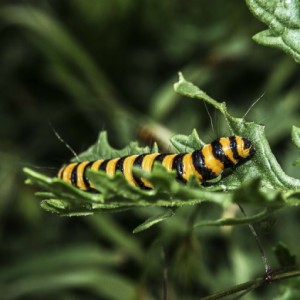Rhea on the Nest
After a visit to a friend in Dunbar, we took Merlin for a walk along the John Muir Way; it's good value, you get to walk along by the East Links Family Farm fence and you don't have to pay to see the exhibits. This rhea was incubating some eggs that were due hatch any day soon, the old girl was very tolerant and merely observed us as we went about our business. I see from their on-line newsletter that the chicks have since hatched and are now being proudly paraded before the public.
Near the car park, we came across some of these stripy caterpillars (see the extra) and anything with this type of marking is either dangerous, or making the pretence of being so; it was worth taking the long view and blipping it. Googling the obvious description takes you straight to the Wikipedia page and it turns out to be the caterpillar of the cinnabar moth (Tyria jacobaeae). The moth is dark grey with red bars and spots (the colour of the mineral cinnabar), hence its name.
The caterpillars main food is the bitter tasting and poisonous ragwort, properties that they develop for themselves and, since they can strip an area of the plant, they can become cannibalistic to avoid starvation; it's a common trait amongst the animal kingdom with cuddly owl chicks eating their smaller siblings and upsetting British television viewers of the “Springwatch” nature programmes.
Originally indigenous to the Eurasian landmass, the cinnabar moth has, together with the ragwort flea beetle, been exported to the Americas and Australasia to control ragwort; I wonder if it worked? So often these well-meaning human interventions go badly wrong.
Many years ago, I was given a sample of bitter tasting honey, it was described as "spicy," After some research, I eventually decided that it contained ragwort nectar.
Posted on the 28th of July.


Comments
Sign in or get an account to comment.


